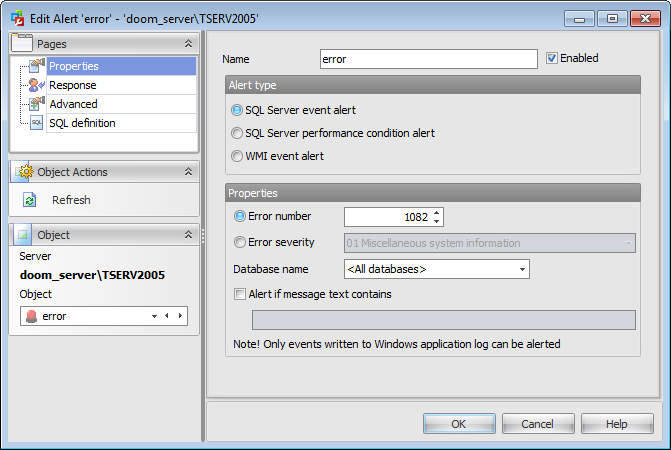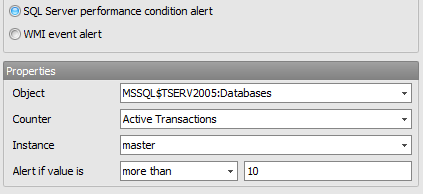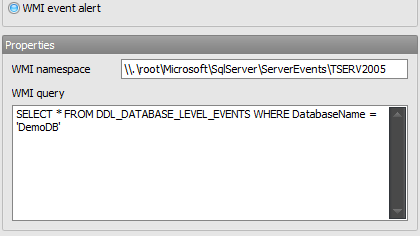Online Documentation for SQL Administrator for SQL Server
Setting alert properties
Use the Alert tab of Alert Editor to configure/view alert properties.
Name
Enter a name for the new alert, or modify the name of the alert being edited. Enable/disable the alert using the ![]() Enabled option.
Enabled option.
Alert type
An alert responds to an event of a specific type: SQL server event, SQL server performance condition or WMI event.
![]() SQL Server event alert
SQL Server event alert
Specify properties for the alert that responds to a server event.

Properties:
Use the following parameters to specify the events that will trigger the alert:
![]() Error number
Error number
Select this option to specify that SQL Server Agent will fire the alert when a specific error occurs. Use the spinner control to specify the Error ID.
![]() Error severity
Error severity
Select this option to specify that SQL Server Agent will fire the alert when any error of the specific severity occurs. Use the drop-down list to select the Severity level: 01-25. For example, you can specify a severity level of 15 to respond to syntax errors in Transact-SQL statements.
Database name
SQL Server Agent fires an alert only when the event occurs in a particular database. Select a database from the list of databases that reside on the specified SQL Server instance.
Alert only when message text contain
SQL Server Agent fires an alert when the specified event contains a particular text string in the event message.
![]() SQL Server performance condition alert
SQL Server performance condition alert
Specify properties for the alert that responds to a SQL server performance condition.

Use the following parameters to specify the server performance conditions that will trigger the alert:
Object
Use the drop-down list to select the area of performance to be monitored.
Counter
Use the drop-down list to select the attribute of the area to be monitored.
Instance
Use the drop-down list to define the specific instance (if any) of the attribute to be monitored.
Alert if value is
Using these boxes you should specify the threshold for the alert and the behavior that produces the alert. Use the drop-down list to select the behavior value: less than (falls below), equal to (becomes equal to), more than (rises above). Use the Value edit-box to specify the threshold number that describes the performance condition counter.
![]() WMI event alert
WMI event alert
Specify properties for the alert that responds to a WMI event.

WMI is an acronym for Windows Management Instrumentation. WMI is the Microsoft's implementation of Web-Based Enterprise Management (WBEM) - a new management technology that allows software to monitor and control managed resources throughout the network.
One common way to use the WMI Event Provider is to create SQL Server Agent alerts that respond to specific events. SQL Server Agent submits a WQL request, receives WMI events, and runs a job in response to the event.
WMI namespace
Specify the WMI namespace on the machine where SQL Server is running.
WMI Query
Use this area to specify the WMI query text for the alert.
The WMI Query Language (WQL) is a subset of standard American National Standards Institute Structured Query Language (ANSI SQL) with minor semantic changes to support WMI.
Examples:
SELECT * FROM Win32_OperatingSystem WHERE Caption="Microsoft Windows XP Professional" AND CSDVersion="Service Pack 2"
If one needs to monitor the number of processes which use more than 10 threads, the following query can used:
SELECT ThreadCount FROM Win32_Process WHERE ThreadCount>10
The following WQL query retrieves specific event properties for any event that occurs in the AdventureWorks database and exists under the DDL_DATABASE_LEVEL_EVENTS event group:
SELECT SPID, SQLInstance, DatabaseName FROM DDL_DATABASE_LEVEL_EVENTS WHERE DatabaseName = 'AdventureWorks'



































































